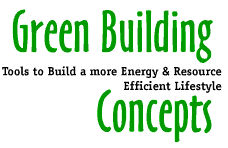 |
 |
 |
| |
 |
 |
 |
 |

Several popular building materials are used to construct the home. Rammed earth, straw bale, auto tires, and glass bottles are more esoteric materials which are gaining acceptance.
Wood
The ubiquitous 2 x 4 or more specifically dimensional lumber is the primary
structural component in homes. A material used for hundreds of years from
log cabins to platform structures, this building technique is well understood
using a renewable resource. Caution is warranted if considering timber use
outside the bounds of sustainable harvesting. In extreme climates termites
may be a problem or moisture failure to wood structures. No special tools
are needed other than a hammer and nails. Wood is tolerant to novices, and
with the use of structural connectors, wood is as attractive as ever.
- Simpson Strongtie, structural connectors
- Steel or Wood?, Environmental Building News
Structural Insulated Building Panel
A marriage of engineered wood and foam, the building monolithic panel uses
EPS (expandable polystyrene) insulation, similar to the foam coffee cup,
but 6 to 12 inches thick, sandwiched between two panels of oriented strand
board (OSB or engineered wood panel). Both products are environmentally friendly.
The OSB uses fast growing trees once considered "trash trees" or
unusable to dimensional lumber specifications. With a uniform thickness and
construction, all walls are sound without the voids common in wood framing.
Many times the panels are finished away from the construction site allowing
straighter walls. A superb building system.
- Structural Insulated Panel Association
- Premier Building Systems
- R-Control Building Systems
- Structural Board Association
Steel
Touted as a replacement for wood, steels is strong, termite resistant, and
offers some fire protection. Generally steel is North America's number one
recycled material, allowing steel products to become new steel products after
their useful lifetime is over. Steel is a nonrenewable resource. The lifetime
of a typical home is somewhere between 250 and 500 years, and through mining
for the steel components, a much greater environmental impact occurs over
wood. Steel is best used where strength is required like car bodies or appliances,
and then enter the recycle stream instead of the waste stream or "buried"
in a long lived home. Steel studs also require specialized tools and skills.
Insulated Concrete Form
While this may seem an odd wall material, just think of all the commercial
property that have their walls made from concrete. Using a lightweight form,
usually of foam and reinforcing bars, t he concrete fills the hollow cavity
between the foam and honeycomb of bars. The wall is rock solid, sound proof,
bug proof, and maybe bullet proof. Concrete systems require specialized skills,
and make sense where strength is needed. I would think it is a negative system
in earthquake regions where seismic impact is directly proportions to the
mass of a home.
| Consulting | Digital Lifestyle | DVD Guide | Green Living | Building Hints | Product Tips |
| OS X updates | Free Newsletter | Pricing | Home | Contact | Site Map |
| Search | |||||
|
Copyright © 1997-2006 Green Building Concepts. All rights
reserved. Please click here for the Terms and Conditions of Use applicable to this site. Use of this site signifies your acceptance of the Terms and Conditions of Use. Direct all questions and comments about the web site to | |||||